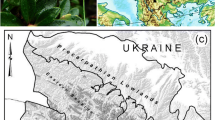Abstract
The structural causes of variation in leaf mass per area, and of variations in leaf structure accounted for by leaf habit and life form, were explored in a set of laboratory-grown seedlings of 52 European woody species. The leaf traits analysed included density, thickness, saturated mass/dry mass, and leaf nitrogen per mass and per area. Other traits described the anatomy of leaves, most of them relating to the lamina (proportions of palisade and spongy parenchymata, epidermis, air space and sclerified tissues, expressed as volume per leaf area, and per-cell transversal areas of epidermis and parenchymata), and another referring to the mid rib (transversal section of sclerified tissues). Across the whole set of species leaf mass per area was correlated with leaf density but not with thickness, and this was confirmed by taxonomic relatedness tests. Denser leaves corresponded with greater proportion of sclerified tissues in the lamina, smaller cells and lower water and N contents, but no relation was found with the proportion of air space in the lamina. Taxonomic relatedness analysis statistically supported the negative association of leaf density with saturated to dry leaf mass ratio. Thicker leaves also exhibited greater volume per leaf area and greater individual cell area in each of the tissues, particularly parenchyma. Mean leaf mass per area and leaf thickness were lower in deciduous than in evergreen species, but no significant differences in leaf density, proportion of sclerified tissues in the lamina or cell area were found between the two groups. Leaf mass per area was higher in trees and subshrubs than in shrubs and climbers-plus-scramblers, this rank being equal for leaf density and proportion of sclerified tissues in the lamina, and reversed for cell area. Given the standardised environment and ontogenetic phase of the seedlings, we conclude that variation in leaf structure and anatomy among species and species groups has a strong genetic basis, and is already expressed early in the development of woody plants. From an ecological viewpoint, we can interpret greater leaf mass per area across this species set as greater allocation to support and defence functions, as shown predominantly by species from resource-poor environments.
Similar content being viewed by others
Author information
Authors and Affiliations
Additional information
Received: 16 August 1999 / Accepted: 29 March 2000
Rights and permissions
About this article
Cite this article
Castro-Díez, P., Puyravaud, J. & Cornelissen, J. Leaf structure and anatomy as related to leaf mass per area variation in seedlings of a wide range of woody plant species and types. Oecologia 124, 476–486 (2000). https://doi.org/10.1007/PL00008873
Issue Date:
DOI: https://doi.org/10.1007/PL00008873




